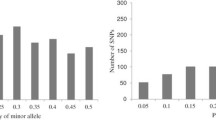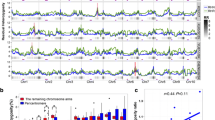Summary
Variation in recombination rate is important to plant breeders since a major objective is to obtain favorable recombinants of linked genes. The ability to increase recombination (R) in circumstances in which favorable and unvavorable genes are linked (Corn Belt x exotic populations) and to decrease recombination when many favorable genes are linked (narrow-based, elite populations) would be of immense value. However, the concept of variation in recombination frequencies between linked genes has received limited attention despite its implications in breeding and genetic linkage studies. Molecular techniques have allowed better estimations of this variation. In this study, attempts were made to characterize: (1) the R values in the Pgm1-Adh1 and Adh1-Phi1 adjacent regions of chromosome 1 and the Idh2-Mdh2 region of chromosome 6 in F2 families of three maize (Zea mays L.) populations; (2) the environmental effect on R values of F2s from two populations. One population, NSO, was a Corn Belt synthetic, and the other two populations, CBMEX3 and CBCAR5, were composites from crosses between Corn Belt and exotic germ-plams.
Wide ranges of estimated recombination (\(\hat R\)) values were observed among families in each population for all three chromsomal regions. The distribution of \(\hat R\) values for the Pgm1-Adh1 region showed that the F2 families of each population fell into two broad categories: 0.30–0.50 and 0.02–0.20. No intermediates (0.21–0.29) were found. The distributions were almost normal for the Adh1-Phi1 and the Idh2-Mdh2 regions. It would appear that the major dispersion in the Pgm1-Adh1 region was controlled by the effects of a single gene, while the Adh1-Phi1 and Idh2-Mdh2 regions were only affected by polygenes. No correlation was found between recombination values of the two adjacent regions, indicating that the genes affecting recombination for the Pgm1-Adh1 region may be specific for that region.
For the Pgm1-Adh1 region, no differences in \(\hat R\) values were found among the three populations. For the Adh1-Phi1 region, \(\hat R\) frequencies of CBMEX3 and NSO were not significantly different, but both had significantly greater \(\hat R\) values than CBCAR5. For the Idh2-Mdh2 region, CBMEX3 was significantly different from NSO. There were significant differences between some paired F2 families within each population for each chromosome region.
No significant differences in response to the two environments were detected in CBMEX3 and NSO for either region in chromosome 1.
Similar content being viewed by others
Reference
Acton AB (1961) An unsuccessful attempt to reduce recombination by selection. Am Nat 95:119–120
Allard RW (1956) Formulas and tables to facilitate the calculation of recombination values in heredity. Hilgardia 24:235–278
Beadle GW (1930) Genetical and cytological studies of Mendelian asynapsis in Zea mays. Cornell Univ Agric Exp Stn Mem 129:1–23
Beavis WD, Grant D (1991) A linkage map based on information from four F2 populations of maize (Zea mays L.). Theor Appl Genet 82:636–644
Bishop YMM, Fienberg SE, Holland PW (1975) Discrete multivariate analysis. MIT Press, Cambridge, Md.
Brown AHD, Allard RW (1969) Inheritance of isozmye differences among the inbred parents of a reciprocal recurrent selection population of maize. Crop Sci 9:72–75
Cardy BJ, Stuber CW, Goodman MM (1980) Techniques for starch gel electrophoresis of enzymes from maize (Zea mays L.). Dept Stat Mimeo Ser no 1317, N.C. State University, Raleigh, N.C.
Carson HL (1953) The effects of inversions on crossing over in Drosophila robusta. Genetics 38:168–186
da Cunha AB, Dobzhansky Th (1954) A further study of chromosomal polymorphism in Drosophila Willistoni in its relation to the environment. Evolution 8:119–134
Detlefsen JA, Clemente LS (1923) Genetic variation in linkage values. Proc Natl Acad Sci USA 9:149–156
Detlefsen JA, Roberts E (1921) Studies on crossing over. I. The effect of selection on crossover values. J Exp Zool 32:333–354
Dewies AA (1969) Two-way selection for recombination rates in Tribolium castaneum. Genetics 64:16–17
Dobzhansky Th, Levene H, Spassky B, Spassky N (1959) Release of genetic variability through recombination III. Drosophila prosaltans. Genetics 44:75–92
Edwards MD, Stuber CW, Wendel JF (1987) Molecular-marker-facilitated investigations of quantitative-trait loci in maize. I. Numbers, genomic distribution and type of gene action. Genetics 116:113–125
Elliot CG (1955) The effect of temperature on chiasma frequency. Heredity 9:385–398
Enns H, Larter EN (1962) Linkage relations of ds: a gene governing chromosome behaviour in barley and its effect on genetic recombination. Can J Genet Cytol 4:263–266
Gale MD, Rees H (1970) Genes controlling chiasma frequency in Hordeum. Heredity 25:393–410
Goldschmidt R (1917) Crossing over without chiasmatypie. Genetics 2:82–95
Gowen JW (1919) A biometrical study of crossing over. On the mechanism of crossing over in the third chromosome of Drosophila melanogaster. Genetics 4:205–250
Graubard MA (1934) Temperature effect on interference and crossing over. Genetics 19:83–94
Hinton CW (1970) Identification of two loci controlling crossing over in males of Drosophila ananassae. Genetics 66:663–676
Kale PE (1968) Spontaneous crossing over in the males of Drosophila ananassae: Two-way selection for recombination values. Jpn J Genet 43:27–31
Lawrence MJ (1958) Genotypic control of crossing-over on the first chromosome of Drosophila melanogaster. Nature 182:889–890
Lawrence MJ (1963) The control of crossing over in the X-chromosome of Drosophila melanogaster. Heredity 18:27–46
Levine RP, Dickinson JI (1952) The modification of recombination by naturally occuring inversions in Drosophila pseudoobscura. Genetics 37:599–600 (abstr)
Levine RP, Levine EE (1954) The genotypic control of crossing over in Drosophila pseudoobscura. Genetics 39:677–691
Lindsley DL, Sandler L, Nicoletti B, Trippa G (1968) Genetic control of recombination in Drosophila. In: Peacock WJ, Brock RD (eds) Replication and recombination of genetic material. Aust Acad Sci, Canberra, Australia, pp 253–269
Longley AE (1927) Supernumerary chromosomes in Zea mays. J Agric Res 35:769–784
Longley AE (1938) Chromosomes of maize from North American Indians. J Agric Res 56:177–195
Mather K (1939) Crossing over and heterochromatin in the X chromosome of Drosophila melanogaster. Genetics 24:413–435
McClintock B, Kato TA, Blumeschein A (1981) Chromosome constitution of races of maize. Colegio de Post Graduados, Chapingo, Mexico
McNelly CA, Frost LC (1963) The effect of temperature on the frequency of recombination in Neurospora crassa. Genetics 48:900 (abstr)
Moens PB (1969) Genetic and cytological effects of three desynaptic genes in tomato. Can J Genet Cytol 11:857–869
Morgan TH, Bridges CB, Schultz J (1935) Constitution of the germinal material in relation to heredity. Yearb Carnegie Inst 33:274–280
Mukherjee AS (1961) Effect of selection on crossing over in the males of Drosophila ananassae. Am Nat 95:57–59
Muller HJ (1925) The regionally differential effect of Xrays on crossing over in autosomes of Drosophila. Genetics 10:470–507
Muntzing A, Akdik S (1948) The effect on cell size of accessory chromsomes in maize. Hereditas 34:248–250
Nei M, Imaizumi Y (1968) Efficiency of selection for increased or decreased recombination. Am Nat 102:90–93
Nel PM (1970 a) Evidence for an effect of the elongate gene on crossing over in chromosome 5. Maize Genet Coop Newsl 44:61–65
Nel PM (1970b) A genetic factor which affects crossing over in chromosome 5. Maize Genet Coop Newsl 44:66–68
Parson PA (1958) Selection for increased recombination in Drosophila melanogaster. Am Nat 92:255–256
Plough HH (1917) The effect of temperature on crossing over in Drosophila. J Exp Zool 24:147–209
Plough HH (1921) Further studies on the effect of temperature on crossing over. I Exp Zool 32:187–202
Powell JB, Nilan RA (1963) Influence of temperature on crossing over in an inversion heterozygote in barley. Crop Sci 3:11–13
Rees H (1955) Genotypic control of chromosome behaviour in rye. I. Inbred lines. Heredity 9:93–116
Rees H (1957) Genotypic control of chromosome behaviour in rye. IV. The origin of new variation. Heredity 11:185–193
Rees H, Thompson JB (1956) Genotypic control of chromosome behaviour in rye. III. Chiasma frequency in homozygotes and heterozygotes. Heredity 10:409–424
Rifaat OM (1959) Effect of temperature on crossing over in Neurospora crassa. Genetica 30:312–323
Ritter E, Gebhart C, Salamini F (1990) Estimation of recombination frequencies and construction of RFLP linkage maps in plants from crosses between heterozygous parents. Genetics 125:645–654
Slocum MK, Figdore SS, Kennard WC, Suzuki JY, Osborn TC (1990) Linkage arrangement of restriction fragment length polymorphism loci in Brassica oleracea. Theor Appl Genet 80:57–64
Soost RK (1951) Comparative cytological and genetics of asynaptic mutants in Lycopersicon esculentum Mill. Genetics 36:410–434
Stadler LJ (1926) The variability of crossing over in maize. Genetics 11:1–37
Stern C (1926) An effect of temperature and age on crossing-over in the first chromosome of Drosophila melanogaster. Proc Natl Acad Sci 12:530–532
Stuber CW, Wendel JF, Goodman MM, Smith JSC (1988) Techniques and scoring procedures for starch gel electrophoresis of enzymes from maize (Zea mays L.). Tech Bull 286. N. C. Agric Res Serv, N. C. State University, Raleigh, N.C.
Sturtevant AH (1917) Genetic factors affecting the strength of linkage in Drosophila. Proc Natl Acad Sci USA 3:555–558
Suiter KA, Wendel JF, Chase JS (1983) Linkage 1: A PASCAL computer program for the detection and analysis of genetic linkage. J. Hered 74:203–204
Towe AM, Stadler DR (1964) Effects of temperature on crossing over in Neurospora. Genetics 49:577–583
White MJD (1934) The influence of temperature on chiasma frequency. J Genet 29:203–215
Author information
Authors and Affiliations
Additional information
Communicated by A. R. Hallauer
Published as Journal Paper No. 9498 of the Nebraska Agric Res Div, University of Nebraska, Lincoln, Neb. Research supported in part by USDA Competitive Grant 87-CRCR-2359
Rights and permissions
About this article
Cite this article
Tulsieram, L., Compton, W.A., Morris, R. et al. Analysis of genetic recombination in maize populations using molecular markers. Theoret. Appl. Genetics 84, 65–72 (1992). https://doi.org/10.1007/BF00223982
Received:
Accepted:
Issue Date:
DOI: https://doi.org/10.1007/BF00223982




